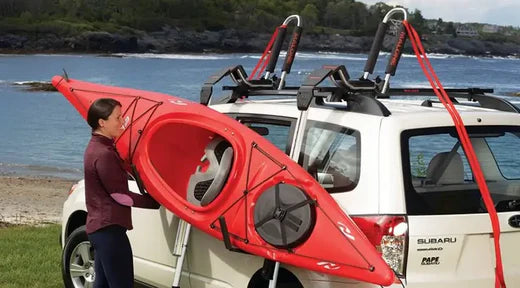Transporting Kayaks: A Guide to Trailers, Pickups, & Roof Racks
May 10, 2024

When it comes to transporting your kayak, there's no one-size-fits-all solution. It's all about finding the best for your needs and budget. Whether you use a sea kayak trailer, pickup truck, kayak roof rack, or a combination, each method will have its benefits and drawbacks. But with the right approach, you'll be on the water, stress-free, in no time.
Transporting a Kayak on a Roof Rack
You can lift your kayak onto a roof rack from its central point. If you're a solo kayaker, consider investing in a loading system, which can make the process easier and safer.
Use at least two middle straps plus bow and stern lines to ensure your kayak stays affixed to the roof rack. Tighten straps properly to prevent your boat from sliding forward and backward while braking or accelerating. Also, protect your vehicle's paint by positioning soft cloth tape or similar material under the straps.
Different Types of Roof Racks for Kayaks
The type of rack you choose hinges on your specific needs, the number of kayaks you plan to transport, and your vehicle's size and shape.
J-Style Racks
The world's most popular kayak racks are called J-style racks or J-cradles. The side-loading, J-shaped design supports your kayak at an angle and makes it easy to tie down your kayak. The main advantage? These J-cradles carry boats on their side, allowing more boats, or combinations of boats and other gear (bikes or cargo boxes, for example) on the crossbars.
Some models do fold when not in use, but this increases height clearance and maybe fuel efficiency, not increase room on the crossbars.
Saddles
If stability is your priority, consider saddles, which are adjustable padded platforms under your kayak's hull, holding it horizontally atop your car's crossbars.
Stackers
Stackers are mostly used with whitewater kayaks and shorter recreational kayaks. And they transport boats on their sides, versus upright.
Temporary Pads
These foam blocks, known as soft rack systems, are only for short journeys and slow speeds. Buckles running through the doors allow you to add or remove temporary pads from your vehicle in seconds.

How to Tie Down a Kayak on a Roof Rack
When transporting a kayak, using tie-downs correctly ensures the kayak's security and prevents any damage during transit. Here are some strategic points for attaching tie-downs:
Using Roof Rack Crossbars
Loop the primary tie-down straps around the kayak and the vehicle's roof rack crossbars. Position these straps near the front and back of the cockpit to provide a balance point and ensure the kayak stays centered.
Using Bow & Stern Lines
Attach additional tie-downs to the bow and stern. Connect these lines to secure points on the vehicle, typically under the front bumper and near the rear bumper or trailer hitch. Bow and stern lines prevent the kayak from shifting forward or backward and help manage the wind forces that act on the kayak while the vehicle is moving.
Kayak Orientation
J-cradles carry boats on their sides, whereas carriers hold the boats in an upright, normal position, meaning the hulls will be in contact with the carriers. If you're not using a carrier or a cradle, we recommend transporting your kayak upside down with the bow facing forward. This will minimize pressure on the kayak and make the transport more aerodynamic, reducing wind resistance and improving gas mileage.
Transporting a Kayak with a Pickup
In some instances, it's possible to transport a kayak on a pickup with a roof rack, but utilizing the bed of a pickup truck is also an option — especially if you'll be traveling a short distance. A kayak rack combined with tailgate pads can create a makeshift cradle for your kayak, if you prefer to leave the tailgate up. If you're comfortable leaving the tailgate down while you drive and letting the kayak stick out, place a red flag on the end for visibility and secure the kayak with tie-downs.
If you have a truck with a shorter bed or a bed extender, such as the Extend-A-Truck accessory, attached using a trailer hitch receiver is your best bet. This long T-bar supports the overhanging kayak and is economical compared to a roof-rack system.
Safety Tips for Transporting Kayaks with Pickups
While transporting your kayak using a pickup, the priority is ensuring your kayak's safety throughout the journey.
- To prevent the ratchet straps from damaging your truck's paint, use a buffer – such as a cloth – between the strap and the truck's surface.
- Tighten the bow and stern lines, restricting the kayak's movement while accelerating or braking. Refrain from over-tightening them on fiberglass boats, which could crack when you hit a large bump.
- Check the forecast and wind strength during the journey, as ratchet straps might lose tension in high winds.
Transporting a Kayak with a Trailer
If you're a part of a family of kayakers, a roof rack system might not cut it. This is when using a kayak trailer, which can transport multiple kayaks simultaneously, comes into play.
Kayak trailers have several advantages. They are lower to the ground, making it easy to load and unload all different sizes, weights, and types of kayaks. They're also more aerodynamically efficient, hiding your kayak from the wind, saving fuel, reducing wear on your vehicle, and almost definitely rated to carry more weight than your vehicle's roof.
Types of Trailers for Kayak Transport
Transporting your beloved kayak safely and efficiently should be a top priority. But with so many kayak trailers available, how do you narrow your options?
- Aluminum & galvanized steel trailers are popular choices for their balance of durability and affordability. With proper care and maintenance, they can weather the elements and reliably transport your kayak.
- Hybrid trailers are versatile multifunctional trailers that carry kayaks, luggage boxes, and bicycles. Some even feature a mesh basket for wet gear, bags, or a foldout tent.
- Commercial trailers are designed to hold multiple kayaks and are built for heavy-duty use. They're popular among businesses that offer kayak rental or guided tours.
Factors to Consider When Selecting a Kayak Trailer
- Size, weight, & number of kayaks: Consider the size and weight of your kayak and how many you'll need to transport frequently. You'll need a dual kayak trailer or quad kayak trailer for multiple boats.
- Vehicle compatibility: It's crucial to ensure your chosen trailer can attach safely to your vehicle. Before making a purchase, verify the hitch type and weight rating. It's likely that most cars will only be able to tow a small kayak trailer.
- Construction material: Whether to opt for aluminum or steel largely depends on your budget and the maintenance you're willing to put in.
- Versatility and add-ons: A hybrid trailer could be the most practical choice if your excursions often include cycling, camping, and kayaking. Add-ons like luggage boxes or bike racks can prove invaluable.

Special Considerations for Kayak Transportation
When managing kayak transportation, there are various considerations to ponder, ranging from travel speed, road types, and weather conditions to the legalities of overhang.
Highway Travel vs. Local Roads
The high-speed winds you typically encounter on highways can influence transport equipment like roof racks. Ensure your kayak is securely fastened, and regularly check the tightness of your rack straps. In contrast, local roads offer slower speeds and less wind resistance, which may lead to less equipment stress and a more stress-free experience.
Weather Factors
Weather conditions add another layer of complexity to kayak transportation. Strong winds can sway your vehicle, particularly if you're hauling a lengthy kayak. Always check the local weather forecast before setting out and reduce travel speed for safety in windy conditions.
Overhang Precautions
Your kayak's overhang — the distance it extends beyond your vehicle — is not just a practical consideration but a legal one. Local and state laws vary, but you must flag during daylight hours and illuminate anything more than 4 feet beyond your vehicle at night. Excessive overhangs can also create a hazard to other drivers, so ensure your kayak is as centrally positioned as possible.
Care for Your Transport Equipment
Maintaining your kayak transport gear in good condition is as important as caring for your kayak. Check your gear for any signs of wear and tear before setting out on your trip, and replace any worn or damaged parts, such as straps, to ensure they don't fail while in transit. You should also invest in a wall-mounted. or freestanding kayak rack to protect your boats when not in use.
DIY Solutions & Hacks for Kayak Transport
With some out-of-the-box thinking, you can make the journey from your home to your favorite waterway easier and stress-free, with no expensive equipment necessary.
For instance, some kayakers use pool noodles as temporary pads for their roof racks. Another solution is a DIY tie-down system. Let's say you don't have any suitable hooks on the undersides of your car. A cylindrical object from your house, such as a cheese grater, can serve as an anchor. Run a cam strap through the object and tie it off, making sure the object is large enough to stop the strap from sliding through a closed hood.
Or what about using an empty soap dispenser cut from the bottom? Thread another strap through it and use this for the stern tie-down. It might look unprofessional, but it effectively ensures your kayak is secure when traditional methods differ.
Inflatable Kayaks for Easy Transport
If transporting a hardshell kayak is challenging, lightweight inflatable kayaks might be a better alternative for you & your family, especially if you don't want to mount a roof rack on your car. These kayaks not only provide the same paddle experience but also offer hassle-free transportation. Simply deflate them after use, fold them up, and carry them in a backpack or store them in your vehicle's trunk for the journey. With this method, you won't need to worry about securing them to a roof rack or truck bed.
Frequently Asked Questions
How do you transport a kayak with a roof rack?
To transport a kayak using a roof rack, ensure it is secure, lying flat, or at an angle. Use tie-down straps to secure the kayak, threading them around the roof rack bars and fixture points. Ensuring the kayak is balanced and does not interfere with vehicle operations is crucial.
What is the best way to transport kayaks?
One of the most effective ways to transport kayaks is with a lift system. These kayak racks easily slide down to your vehicle's side, allowing you to lift your kayak up to waist height. After securing the boat, you push the rack back onto the roof.
How do you transport a kayak on a pickup truck?
A pickup truck can be a great way to get your kayak from point A to point B. Transporting a kayak on a pickup truck requires a roof rack, a bed topper, or crossbars. Crossbars mount over the pickup bed or on top of the cab, allowing you to install a kayak rack. LINE-X pickup truck toppers also provide suitable alternatives.
How do you transport a kayak without a roof rack?
Transporting a kayak without a roof rack can involve DIY solutions like using pool noodles and ropes for temporary padding. However, ensuring security to avoid equipment damage or traffic accidents is vital.
Why are kayak racks angled?
Kayak racks are angled to create more room on your crossbars, allowing you to transport more than one item. J-style kayak racks, in particular, facilitate loading from the side or back of the vehicle.

